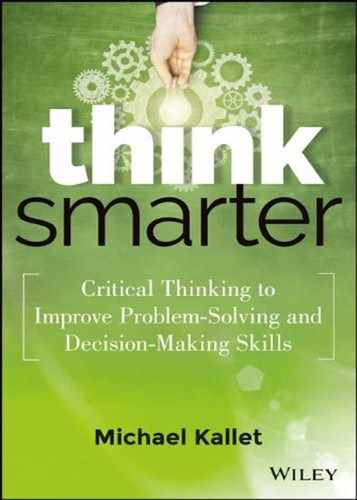Section II Clarity
Clarity, the first and most important step in critical thinking, is about understanding the issue, problem, goal, or objective—the headscratcher that you're looking to solve. If you're not clear, you risk solving the wrong problem. For example, let's say you have to fix a customer problem. What happens if you don't have a clear idea of the problem that customer actually has? You might spend a good deal of time and effort attempting to solve something that wasn't a problem in the first place. Although your customer might really appreciate your effort, you haven't solved the headscratcher.
Here's a specific example: It's Monday morning at 11:00 am. You're in Los Angeles, waiting on a flight scheduled for an 11:30 am departure to Dallas. You have a business meeting that starts at 7:30 am on Tuesday. You hear an announcement: “Folks, we have a mechanical situation on the plane, so I'm afraid this flight is cancelled.” You and 200 other people make a mad dash to the customer service center.
After you wait in line for what seems like forever, the customer agent, who is unbelievably polite and empathetic, gives you the good news: “We've automatically booked you on the first flight out tomorrow morning.”
You respond, “That's just not going to work. I have a 7:30 am meeting tomorrow. Is there any way you can get me to Dallas today?”
The agent responds, “There's a flight through Chicago that leaves in 50 minutes. You can connect to a flight to Dallas at 5:30 pm, arriving at 8:00 pm. Is that okay?”
You say, “Yes!”
Although the agent initially had a solution for getting you to Dallas, that wasn't your problem. Your problem was getting to Dallas today so that you could (1) get some sleep and (2) make your meeting tomorrow.
Without clarity on an issue, you risk redos, mistakes, and even addressing a symptom of a problem but not actually solving the headscratcher.
In this section, we'll introduce 10 tools you can use to get clear. In many instances, you'll probably use only a few at a time. Some you'll use more often than others, and as you practice, you'll probably favor a few. It doesn't matter how many or what tools you use; the objective is to get clear. We'll explain each tool, provide you with examples of using it in your work, and close each chapter with a few exercises to practice. In the last chapter of this section, we'll summarize clarity and the tools that I presented.
The Takeaway
Spend some time getting clear on the headscratcher you are solving—even if you think you already are. A small investment in clarity at the beginning of the process can save a tremendous amount of time and effort later on, because it minimizes the possibility of having to go back and start again because you were unclear.
